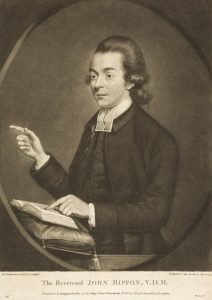


John Rippon (1751 – 1836)
Repertoire:
How Firm a Foundation
Mysteries remain regarding the origin of this wonderful hymn and its tune. The hymn first appeared in Rippon’s most famous work, A Selection of Hymns from the Best Authors, Intended as an Appendix to Dr. Watts, published in 1787 under the title, Exceedingly Great and Precious Promises. It was eventually published 27 times. In early editions the words were accompanied by the letters “K.” or “Kn.” We do know that Robert Keene was the song leader or precentor in Pastor Rippon’s church. He may, or may not, have supplied the text for this hymn. The origin of the tune is also obscure. It comes from A Compilation of Genuine Church Music, published by Joseph Funk in 1832.
In spite of the uncertainty about its origin, this remains one of the greatest hymns in the English language. Almost every line is a quotation of, or allusion to, some text in the Word of God. Each stanza but the first is a poetic quotation of Scripture giving assurance to the believer. The first poses the question and is answered in the following verses. It’s unfortunate that most hymn books limit themselves to using only three or four stanzas. All are worthy to be included and each adds to the thought.
The modern trend is to shorten our hymns. Sometimes the words of only a verse or two are projected on the wall sometimes with the refrain. Seven stanzas must seem like far too much work! But there is an irony to this, since some of the contemporary choruses are sung over and over again, repetitiously. We should want to hear the entire thought that was laid on the writer’s heart. By omitting parts of our better hymns, we definitely miss a blessing.
The opening stanza of our hymn reminds us that the Scriptures are trustworthy, and a firm foundation on which to stand. It asks the question: What more can He say than to you He hath said? The following verses supply the Scripture to support that statement. When the Bible speaks of the household of God being “built on the foundation of the apostles and prophets” (Eph. 2:20), it means that our foundation is the Word of God revealed through them (cf. vs. 5). And since the Lord Jesus is central to that revelation, it’s equally true to say that He Himself is our foundation (I Cor. 3:1).
John Rippon (29 April 1751 – 17 December 1836) was an English Baptist minister. He was born at Tiverton, Devon, England. In 1768, at about age 17, he enrolled in and was educated for the ministry at the Baptist College, Bristol. More than 250 years later (2020), this school is still in existence and educating students. In 1773, Rippon became Pastor of the Baptist church in Carters Lane and he continued to preach and care for the congregation until his death on December 17,1836. Pastor Rippon was one of the most popular and influential Dissenting Ministers of his time. From 1790 to 1802 he issued the Baptist Annual Register, a periodical containing an account of the most important events in the history of the Baptist Denomination in Great Britain and America during that period. He published another hymnal, Selection of Hymns for Public Worship, in 1787. In the 1791 edition, and on-going, the names of tunes were prefixed to the hymns which began to establish some consistency in the hymn singing.
After the death of John Gill, he assumed Gill’s pastorate at the Baptist Meeting House in Carter Lane, Tooley Street, Southwark, from 1773 at the age of 20 until his death in 1836. During these times, the church experienced great growth and became one of the largest congregations in the country. The congregation moved to New Park Street from Carter Lane in 1833. The New Park Street Chapel could seat 1,200 people. Rippon’s church was later pastored by Charles Haddon Spurgeon. It was under his leadership that the church moved to its current location as Metropolitan Baptist Church in London at Elephant and Castle. Rippon’s Selection of Hymns was used by the congregation until 1866 when Spurgeon produced an update called Our Own Hymn Book which borrowed much from Rippon and Watts. Rippon was buried in London’s Dissenter Cemetery, Bunhill Fields, London.
was sung at the funerals of Presidents Theodore Roosevelt and Woodrow Wilson. It was the favorite hymn of Rachel Jackson, wife of President Andrew Jackson, and on his deathbed the warrior and statesman called for it. It was also sung at the funeral of General Robert E. Lee.
Source:
A Dictionary if Hymnology; John Julian; Dover Publications, 1907, New York
Baptist Hymn Writers and Their Hymns; Henry S. Burrage, D.D.; Brown, Thurston & Co. 1888, Portland, ME
The Story of Hymns and Tunes; Theron Brown & Hezekiah Butterworth; American Tract Society, 1906, Boston, MA
